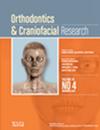Pilot study for three-dimensional cephalometric Enlow's counterpart analysis: Vertical track. Two-dimensional and three-dimensional comparison
Abstract
Background
The introduction of cone beam computed tomography (CBCT) in dentistry has given orthodontists the possibility of studying craniofacial structures in three dimensions. Despite the possibility to obtain lateral cephalograms synthesized from CBCT, this approach still does not provide a fully three-dimensional evaluation of the patient's anatomy. While there has been some success in adapting traditional two-dimensional cephalometric analyses to three dimensions, the specific application of Enlow's cephalometric analysis using CBCT remains unexplored.
Aim
This pilot study aims to introduce a novel approach for performing Enlow's vertical track analysis using CBCT images.
Materials and Methods
Eighteen CBCT images of skeletal Class I (ANB = 2 ± 2) subjects (12 males and 6 females, aged from 9 to 19 years) with no history of previous orthodontic treatment were selected. For each subject, 2D Enlow's vertical track analysis was performed on lateral cephalograms extracted from the CBCT images, and separately, 3D vertical track analysis was directly performed on the CBCT images. To validate the proposed method, we compared the differences between the posterior vertical counterpart (PVC) and the middle vertical counterpart (MVC), as well as between the middle vertical counterpart (MVC) and the anterior vertical counterpart (AVC), as obtained from both the two-dimensional and three-dimensional analyses. The Kolmogorov-Smirnov normality test was applied for each variable to check whether data were normally distributed and a paired Student's t-test was performed. The level of statistical significance was .05.
Results
The comparison between three-dimensional PVC-MVC (−0.43 ± 0.37 cm) and two-dimensional PVC-MVC (−0.53 ± 0.36 cm) revealed no statistical difference (P = .27). Similarly, no significant difference (P = .28) was observed between two-dimensional MVC-AVC (−0.56 ± 0.34 cm) and three-dimensional MVC-AVC (−0.47 ± 0.37 cm).
Conclusions
The method proposed by this study to realize the vertical track analysis on 3D images is valid and superimposable on that described by Enlow on lateral cephalograms.

 求助内容:
求助内容: 应助结果提醒方式:
应助结果提醒方式:


